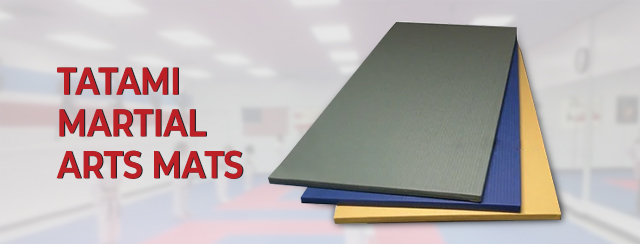Ezy Mats is a supplier of tatami mats. Whether you require a tatami mat or need to fit out your dojo Ezy Mats has you covered. Our tatami come in either black or grey. Other colours are available on special order. The thickness of the mats is 40mm. They are 2m x 1m in size. Again 1m x 1m is available on special order. The mats also come with a textured tatami finish which is designed to add a grip to the surface. The tatami finish was originally intended to mimic traditional Japanese tatami mats.

What is a Tatami Mat
A tatami mat is a mat or set of mats used in martial arts and other training. The tatami mat is made from compressed foam and are covered in vinyl. There is a rubber surface on the back of the mat. The rubber surface helps reduce slipping during training.
Tatami Mats Uses
These mats are used in a cross-section of martial arts including judo, jiu jitsu, wrestling, karate, tae kwon do, kick boxing, kung fu, aikido etc. Our mats are also idea for other activities such as yoga, cross-training etc.
Ezymats endeavour to be the most economical supplier of tatami martial arts mats in Australia. Should you find cheaper mats elsewhere we promise to do our best to beat any reasonable quote for the same product.
Benefits Of Vinyl Mats
- Easy to install
- Made from Vinyl and compressed foam
- Duarable and easy to clean
- Offer great protection and Comfort
- Suitable for all forms of martial arts & training
- Textured finish for added grip
- Rubber non-slip back
Contact Ezy Mats For Your Mats Needs
Please contact Ezymats before making your purchase from another supplier and you won’t be disappointment.
History of Tatami Mats
The Ezymat Tatami is one of our most sought after products and it is a high-quality product which guarantees satisfaction, whether you need it for house flooring or for a martial arts dojo. The sacred Tatami mat has a cult status in Japan, and it is valued greatly among one of the greatest sensei throughout the ages. We will explore its lush history and analyze the impeccable technique of how it’s made. We at Ezymats also value its sacred status and story of origin, as it is a very durable and high-quality flooring material which never fails to impress.
The standard traditional tatami mat, generally speaking, is popularized in the common martial arts dojos throughout the western countries. Up to seven thousand rush pieces were used in making Tatami mats. Cities like Hiroshima and Fukuoka are popular today for their production and manufacture of rush grass, or Igusa. The heavy duty machines in the highly industrialized cities are being improved faster than ever before.
The Nara Period
The ancient tatami mats have been used since the Nara Period, 8th century Japan and the word “Tatami” is found in one of the oldest Kojiki books which was used in recording the ancient history of Japan. But the most popular and commonly known Tatami mat was widely popularized in the Heian period from the 9th century to the turn of the 1200s.
In the earlier versions, the tatami straws were thinner, but they became much thicker and by the Muromachi period, emerged the popular Tatami rooms, all filled with Tatami mats as a basic flooring material. By the Edo period, Tatami mats were becoming more and more of a household item, and a great number of the traditional Japanese royalties and noblemen had them in their possession.
There were also professions where a man would be responsible for the setup and arrangement of Tatami mats. The noblemen’s rooms, which were filled with Tatami mats, were known as ‘zashiki’, all of which were arranged according to the room’s use and size. Many Japanese noblemen, merchants and royalty in the Heian period used Tatami mats for sitting.
Tea Ceremonies and later uses
Tea ceremonies around the 16th century were nothing without a proper Tatami setting. The tea rooms were usually smaller and required no more than two Tatami mats, paving the way to a more popularized approach in the ancient minimalistic room-settings of Japan.
Proper etiquette was highly regarded, as it was dishonorable to leave your shoes on while entering a Tatami room. So, in order to fully respect the Tatami and the room itself, one must always remove their shoes. It was quite the faux pas move to do as such in this period of Japan.
The once highly expensive Tatami mats were utilized in many of the common folk’s homes around the 17th century. So, it was not just the noblemen’s luxury around this period, it was a period of social flourish in contrast to the ancient times. From then on, there has been a frequent decline of the traditional Japanese setting, due to the popularisation of the Westernisation in the Japanese interiors.
Tatami in Modern Japan
Nevertheless, there still are Tatami rooms in the modern Japanese homes despite the rapid decline in popularity. In the Western countries, Tatami mats are mostly popularized from the martial arts dojos. They are made of woven grass around rice straws as a core, ensuring a very stable structure and texture. Smooth and tidy, they have a very firm stability and are quite durable.
Our Tatami mats are a perfect marriage between the old and the new. The Ezymats Tatami is made with vinyl, as a more modern approach, and topped off with a Tatami finish, according to the ancient ways. They are a modern surface for any high-impact sport which is perfect for judo, aikido, and other martial arts training usages.
Ezymats utilize the Tatami mat tradition with a state of the art modern twist with a vinyl finish. The traditional tatami finish and heavy duty vinyl with an inner compressed sponge and anti-skid bottom promises absolute stability and durability.


Follow us:


